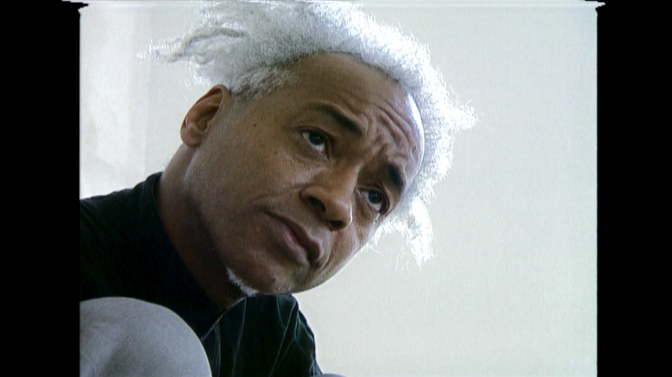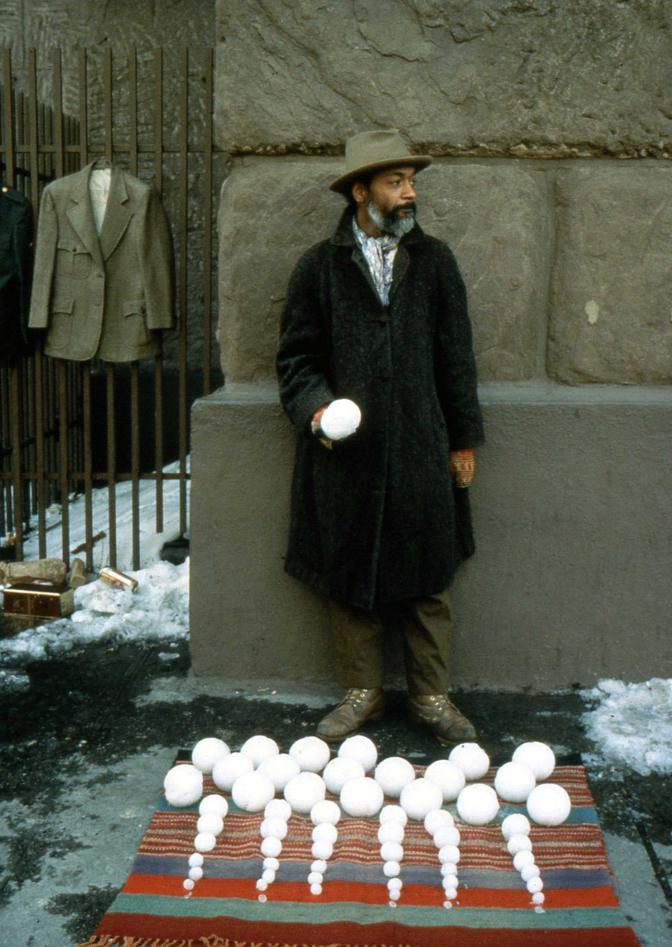For a baker’s dozen of years beginning in the late 1990s, I was the editor of a monthly reference journal called Current Biography. Our articles on accomplished living people relied heavily on secondary sources; in the course of writing and editing each 2,500-word biography of an actor, businessperson, writer, athlete, scientist, politician, musician, or what have you, my staff and I combed through dozens of published reviews, interviews, and profiles. Over the years, I discovered that when it came to what I will call—for the sake of this Catholic publication—flimflam, the biographical subjects who inspired most of it fell mainly into one category: visual artists.
As far as I could tell, this was not the fault of the art critics, or not entirely. It often seemed as though, having pages to fill, and having themselves been conned by the artists, those critics set out, consciously or otherwise, to con the rest of us—using hot air to pad their takes on the meanings of the work under review. One artist, for example, exhibited what he claimed was a section of his own bedroom wall, significant to him because of the countless hours he had stared at it. Perhaps that stands out in my memory because one critic, after waxing poetic about the section of wall, added—uncharacteristically for one in his occupation—that one might be tempted to view the work as a scam. Yes, I recall thinking. Yes, indeed, one might.
The vast majority of the artworks that inspired flimflam were conceptual. That is no accident. An element usually absent from works of conceptual art, in my humble experience, is craft. That, of course, is the point of conceptual art, which emerged as a movement in the 1960s: the materials and their manipulation are important neither for the aesthetic pleasure they give nor for the skill they display, but for what they express. It’s the idea, stupid. But in art, for me personally, craft functions as a passport, lending legitimacy to the intentions of the person whose work I am considering. Clearly demonstrated skill at painting, drawing, or sculpting gets us past the first hurdle, letting me know that the work, whether or not I like it, deserves to be taken seriously. By contrast, I tend to yawn, if not roll my eyes, before works that show no sign of what priests call “the work of human hands.” (And if you truly want me to bypass your museum or gallery installation, one time-tested method is to throw in a TV or video monitor.)
These opinions come with two caveats. One is that I recognize that much conceptual art represents serious and legitimate intentions. (I know: very big of me.) What can make it hard to assess the intentions behind conceptual art is the often ineffable nature of the ideas at the center of such work. Those ideas are like small children: precious, delicate, complex, dependent on the support of solid objects and the stewardship of solid people for their survival. But sometimes the quality of those objects and people make one wonder if the ideas, like a Nigerian prince in an email scam, don’t actually exist. The second caveat is that sometimes, in cases in which the craft that went into an art object seems limited or absent, the work itself is still so striking that it doesn’t matter.

That brings us to the work of David Hammons.
In a career that spans six decades, beginning with his student days in Los Angeles in the early and mid-1960s, Hammons—who is African American—has produced work often grounded in ideas of Black community and history. Many of those works can be seen in Harold Crooks and Judd Tully’s 2022 documentary The Melt Goes on Forever: The Art & Times of David Hammons, which consists mainly of interviews with curators, critics, and other artists as well as footage of Hammons himself, often seen alongside his creations. The “work of human hands” is not totally absent from those creations; Hammons’s hands, and much of the rest of him, are in evidence in his famous series of body prints from the late 1960s and 1970s, for which the artist used paint and baby oil to make impressions, on paper, of his physical self—works that, as one commenter observes, make Hammons a stand-in for the very politically charged idea of the Black body.
Another seemingly hands-on, craft-oriented piece was How Ya Like Me Now? (1989), a billboard-sized work portraying the Black activist and presidential candidate Jesse Jackson—who had unsuccessfully sought the Democratic nomination the previous year—with blond hair, blue eyes, and pale skin. Set up in a Washington D.C. parking lot across from the National Portrait Gallery, the work made the point that the charismatic Jackson’s candidacy might have succeeded if he had been white. A group of Black men, interpreting the work very differently, got nationwide media coverage when they set out to destroy it.
For the most part, however, the works seen in the documentary suggest collection and assembly rather than creation, but are often no less powerful for that. Inspired, for example, by a 1970 exhibit at Chicago’s Field Museum that featured garments containing the hair of African tribespeople and worn by their chief, Hammons began collecting hair from Black barbershops and affixing it to large, head-shaped objects, such as rocks. The result is stunning. The “heads” are featureless, drawing our attention that much more strongly to the hair, which came from the heads of living people; the hair seems to bring the objects partway to life, allowing them to represent a community. You half expect them to speak.
Other such works include exhibits of cotton attached to long wooden sticks—cotton having, in a sense, given birth to African Americans because, in Hammons’s words, “If not for cotton, we [i.e., Black people brought from Africa during the slave trade] wouldn’t be here to pick it.” Inspired by Marcel Duchamp’s concept of the “ready-made,” and more directly by the works of the artist Noah Purifoy, which included artifacts from what transpired in 1965 in Watts (variously termed riots, rebellion, and uprising), Hammons collected bottles, bottle caps, and other found objects in Harlem, where he had moved. Among the standout results is Untitled (Night Train) (1989), his circular sculpture of uniformly shaped dark green, light green, and clear bottles of cheap wine (called Night Train). The bottles glisten while revealing a great deal about the community from which they are drawn—their different shades might suggest the array of skin tones to be found in Harlem. The power of such works lies in the melding of the aesthetic and the idea-driven as well as in the labor-intensiveness they suggest. They demand to be taken seriously, because serious thought and effort clearly went into them.

This is not to say that Hammons’s work is free of any suggestion of flimflam. The Melt Goes on Forever begins with a woman telling the story of her 1980s encounter with a man on the street who was selling snowballs. She bought one, thinking she was helping a homeless man. Only later did she learn that she had purchased a piece of art by a famous artist named David Hammons (see cover). The documentary’s commentators (one or two of whom are rather adept at flimflam themselves) note that Hammons is “always trying to find the joke” in what he does, and that his work evokes the Duchampian/Warholian tradition of the “artist as scammer.” That idea could certainly occur to anyone looking at his 1993 work Rock Fan, which is not about music appreciation—rather, it is a giant rock with fans attached—and which Hammons exhibited outdoors on the campus of Williams College for onlookers split equally between admiration and skepticism. The same might be said of his 2007 show in Manhattan that consisted of fur coats spattered (decorated? marred?) with paint. The jokes here could be on the curators—if so, this is a case of willing butts. As the late writer Steve Cannon says in the documentary, the more “Hammons tells the art world to [expletive] itself, the more they want him,” and Hammons “gets a kick out of that.”
How are we to feel about such works when it’s not clear how seriously Hammons himself takes them? The Melt Goes on Forever does not provide an answer; the documentary assiduously avoids expressing a point of view apart from those of the commentators, which in one way is effective, letting both the power of Hammons’s work and the occasional absurdity of the art world speak for themselves—the latter never more hilariously than when an art dealer recalls his effort to purchase and insure one of the artist’s snowballs for $1 million. But the absence of an omniscient viewpoint also makes for a scattershot portrait of Hammons and his career, one that leaves out key biographical details and gives little idea of how and when the artist came to prominence or of the place he occupies in the larger context of the art world, particularly the Black art world. The attentive viewer will learn (from a still photograph of a news clipping that includes the year) that Hammons was born in 1943, and an interviewee explains that he moved twenty years later from Springfield, Illinois, to Los Angeles, where he learned that there were Black artists when he met and studied with Charles White at the Otis Art Institute. Beyond that, the curious will have to look elsewhere for information, finding out, for example, that:
Hammons grew up very poor, the youngest of ten children with a mostly absent father. In L.A. he enrolled in classes in commercial art and design before becoming interested in fine art. He never actually matriculated at Otis; White let him attend night classes for free. Hammons’s career and reputation started with the body prints he began making during that period. He was a part of the era’s Black Arts Movement; his studio in Los Angeles became a hangout for Black artists. In 1975 he had his first show in New York—where he would move five years later—when Linda Goode Bryant exhibited his work at Just Above Midtown, the space she had devoted to showcasing the work of artists of color. He came under Bryant’s wing, and later, as artist-in-residence at the Studio Museum in Harlem, he became an influential figure himself. The 1980s brought him grants from the Guggenheim Foundation and the National Endowment for the Arts; the Prix de Rome followed in 1990, the same year as his retrospective exhibit at MoMA PS1, which represented a milestone in his career. A year later he won a MacArthur Foundation fellowship. It was official: Hammons was a genius. At art? Scamming? Both?
Perhaps in search of an answer, I went on a Thursday in August to the Manhattan’s Whitney Museum of American Art to see Hammons’s permanent exhibit, Day’s End, completed in 2021. The work is not actually in but adjacent to the museum, across the West Side Highway, along the banks of the Hudson River. The massive sculpture is inspired by—and has the exact same location, dimensions, and title as—a since-demolished work by the late Gordon Matta-Clark. In 1975, Matta-Clark cut holes in an abandoned shed on Pier 52. The incisions let in the sun—and let the artist in for a visit by city inspectors, who shut down the unauthorized use of municipal property.

Hammons’s own Day’s End, constructed of metal poles fifty-two feet high, sixty-five feet wide, and 325 feet long, is not a building but resembles the frame of one. Walking from the Whitney to get a closer look at Day’s End meant crossing the traffic-choked highway; I perched on a bench beside a playground at Hudson River Park, which juts out into the river just south of Day’s End, and gazed across the water at the sculpture. Day’s End is half-in and half-out of the water, the poles on one side resting on steps. Construction was taking place very near it; runners and bikers passed by along the multi-use path, not one of them seeming to pay attention to Hammons’s work. I wondered what I would have thought of it myself, or if I would even have noticed it, had I not known it was there. The day was overcast, the undersides of clouds the same color as the metal, nearly subsuming it. The giant red neon “W” on the hotel across the river in Jersey City commanded more attention than Hammons’s work did. You don’t look at Day’s End so much as past it, or through it; the work seems to suggest something that is still to come, or has already left, or else it resembles…well, a few mornings later, over breakfast in a Brooklyn diner, I showed a friend the photo I had taken and asked him what it looked like. “A giant coat rack,” he said. “Bingo,” I replied.
Sitting on the bench, I kept staring at the work, wanting it to mean something, not wanting to feel like I was wasting my afternoon. Then I thought about the title, and something clicked. The words “day’s end” bring to mind life’s end, and suddenly the work looked less like a coat rack than a skeleton—mine, or yours. We are that empty frame, or will be one day. What do we do, as the end approaches, except hope that we haven’t wasted our days? And what will we do between now and that time?
Listen to me—sounding like one of those art critics I used to scoff at while sitting up in the Bronx in my office at Current Biography. Suddenly I felt some empathy for those guys.
And I had questions. If, in conceptual art, the idea is more important than the materials, why do the works require the materials? I argued earlier that the ideas depend for their survival on support by solid objects, but is that really so? Would a flat-out statement of the ideas not work as well? Words on a wall, maybe? Perhaps, though, the reason that Hammons’s Day’s End ultimately works—for me—is that I came to an understanding of its meaning, or what I take to be its meaning, on my own. Another friend of mine once said to me, “I want to learn, but I don’t want to be taught,” and maybe that’s exactly it. That is similar to what I sometimes tell my students of creative nonfiction writing: don’t spell out your ideas all the way—let the reader do some of the work. Perhaps, that way, there is more of a feeling of shared ownership of the ideas. (And anyone who pays thirty bucks to gain admittance to the Whitney should feel like a part-owner.) As owners, we get to do what we want with these ideas, including—if we are not impressed, or if we wonder whether they really are ideas—walking away from them.
I had one other question. Is the meaning I derived from Day’s End the one Hammons intended? Perhaps, staring long enough at anything, anywhere, at any time, I could have arrived at a similar notion. Why do I need Day’s End? But perhaps that is exactly the point.
I thought, with a rueful chuckle, of a moment from The Melt Goes On Forever: Hammons recalled that some people, looking at his work, had said to him, “I could do that.” His response was, “Go on and do it then.”
Please email comments to [email protected] and join the conversation on our Facebook page.
Previous Story
Abolishing Poverty in America
Next Story
Pro-Fascist, Anti-Nazi

